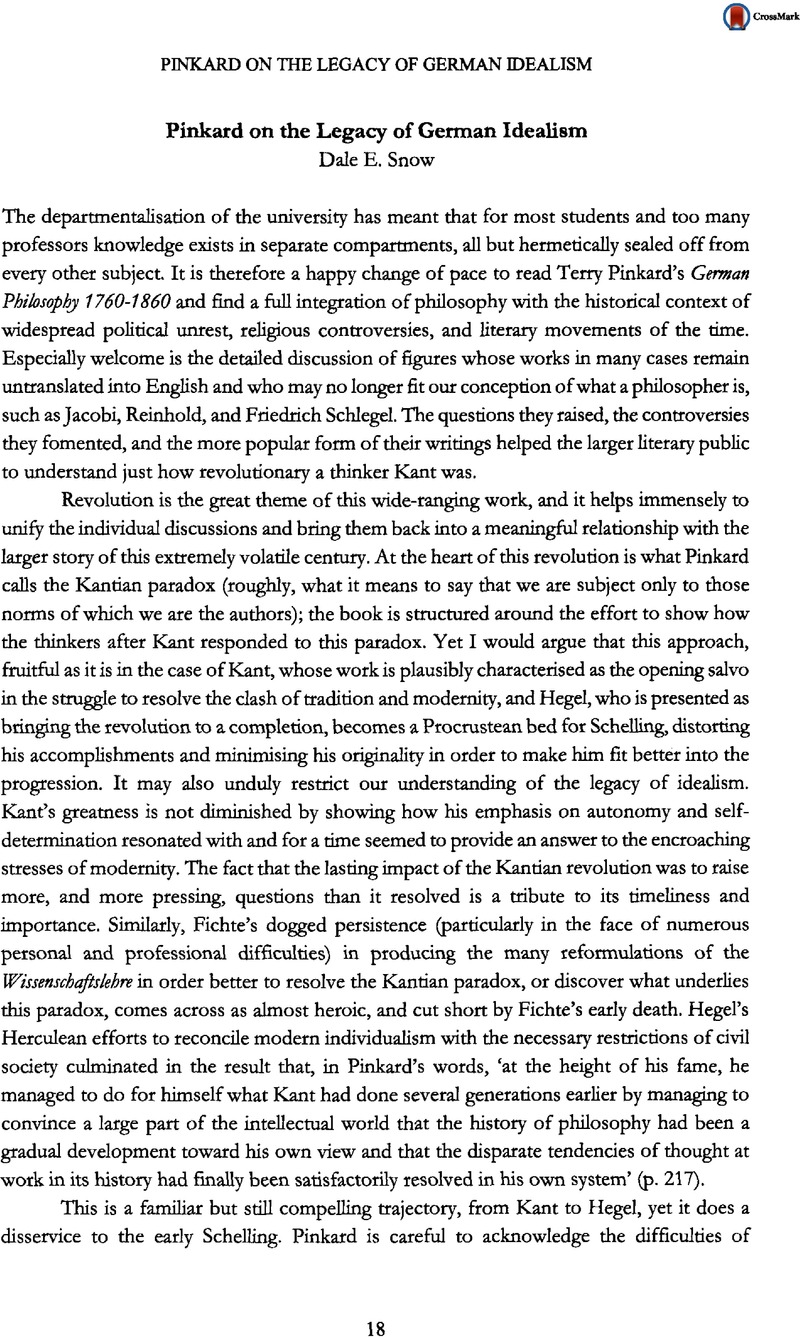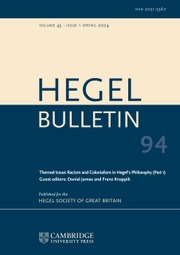No CrossRef data available.
Article contents
Pinkard on the Legacy of German Idealism
Published online by Cambridge University Press: 23 June 2015
Abstract

- Type
- Pinkard on German Idealism
- Information
- Bulletin of the Hegel Society of Great Britain , Volume 25 , Issue 1-2: number 49/50 , 2004 , pp. 18 - 24
- Copyright
- Copyright © The Hegel Society of Great Britain 2004
References
Notes
1 Fichte-Schelling Briefwechsel, ed. Schulz, Waltet, (Frankfurt: Suhtkamp Vetlag, 1968) pp. 137, 140 Google Scholar.
2 Richards, Robert J., The Romantic Conception of Life (Chicago: University of Chicago Press, 2002), p. 135 CrossRefGoogle Scholar. Richards provides a thought-provoking discussion of Goethe's influence on the evolution of Schelling's Naturphilosophie, including the suggestion that frequent meetings with Goethe, to read his work in progress and answer questions, during the period of the composition of the Einleitung zu dem Entwurf prompted Schelling's abandonment of the Fichtean primacy given to transcendental philosophy and the definitive move toward establishing the independence of Naturphilosophie (p. 141-145).
3 Bowie, Andrew, Schilling and Modern European Philosophy (London: Routledge, 1993), p. 30 Google Scholar.
4 See, for example, Harris, H. S., ‘The Cows in the Dark Night,’ Dialogue 26 (1987), 627–644 CrossRefGoogle Scholar, who argues for the prevalence of the image of night as a generative principle in works by Jean PauL Friedrich SchlegeL and Schelling himself; for Harris, Reinhold and Bardili are the likeliest to be the ‘formalists’ of the ‘dark night’. Manfred Frank also suggests that Hegel's ‘images’ (Bilder) in the preface ‘have Schellingian models (Vorbilder)–so frequendy taken from the Further Presentations, that one could suspect that Hegel was using this text while composing the preface’. Der unendliche Mangel an Sein (Munich: Wilhelm Fink Verlag, 1992), p. 152, n.6Google Scholar.
5 I am thinking here of the school of Schelling-interpretation inspired by Walter Schulz's, Die Vollendung des deutschen Idealismus in der Spätphilosophie Schellings (Pfullingen: G. Neske, [1954] 1975)Google Scholar.
6 Beiser, , German Idealism: The Struggle Against Subjectivism 1781-1801 (Cambridge: Harvard University Press, 2002), p.11 CrossRefGoogle Scholar.
7 Ibid., p. 350.
8 See, for example, Annemarie Pieper's claim in her editorial report on the ‘Philosophical Letters’ that Fichte's formulation was composed ‘in enger Ahnlehnung an Schelling's Ausspruch im sechsten Brief.’ Historische-Kritische Ausgabe, 1:3 (Stuttgart: Frommann-Holzboog, 1982), p. 42 Google Scholar.
9 Hegel: A Biography, (Cambridge: Cambridge University Press, 2000), p. 70, pp. 112-113, pp. 191-192, p. 298-301, pp. 481–483 Google Scholar.
10 Pinkard mentions Schleiermacher and Friedrich Schlegel in passing as among those who interpreted Kant's notion of the ‘ethical commonwealth’ as including both men and women of ‘virtue and learning’, evidence that a more egalitarian view was current among some of Hegel's contemporaries (p. 169).


